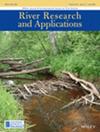描述形态微结构和水峰对河流中鱼类搁浅的影响
IF 1.7
4区 环境科学与生态学
Q4 ENVIRONMENTAL SCIENCES
引用次数: 0
摘要
由于河岸快速脱水,河流中的鱼类搁浅往往发生在水峰的下降阶段,这使得能量生产达到高峰。多种跃水特征和河流形态都会影响搁浅,但人们对河床微结构的影响知之甚少。我们的目标是确定湍流特征与形态微结构(如水坑和冲刷池)的结合如何影响鱼类搁浅。为此,我们使用了一个广泛的鱼类搁浅观测数据集,该数据集在 3 年的春季收集于法国艾因河 50 公里长河段的 48 个地点。我们的目标是:(1)描述搁浅事件及其相关鱼类组合的特征;(2)确定搁浅的时空决定因素。形态微结构的出现是解释鱼类搁浅的主要因素。冲积池影响较大,其次是冲积坑、潮湿区和冲积坑。然后,水文特征与形态相互作用,调节了搁浅的强度。在没有水峰的时期之后出现的低流量范围(低峰值流量和低基本流量)会诱发 "鲑鱼苗 "搁浅事件和 "超级搁浅 "事件(多个类群的大规模搁浅)。其他流量范围则会诱发 "常规鲤科鱼苗 "搁浅事件。在取样初期,鲑科鱼类尤其容易搁浅。建议是:(1) 优先处理最有可能发生搁浅的地点,在常年区域进行形态改造或安装具有吸引力的结构;(2) 在水峰的低流量范围内保持具有吸引力的常年栖息地,例如增加基本流量。本文章由计算机程序翻译,如有差异,请以英文原文为准。
Characterizing the effects of morphological microstructures and hydropeaks on fish stranding in rivers
Fish stranding in rivers, due to rapid shoreline dewatering, often occurs during the down‐ramping phase of hydropeaks, which enables peak energy production. Multiple hydropeaking characteristics and river morphology influence stranding, but little is known about the effects of riverbed microstructures. Our goal was to identify how the combination of hydropeaking characteristics and the occurrence of morphological microstructures (e.g., puddles and scour pools) influences fish stranding. For this purpose, we used an extensive dataset of fish stranding observations collected over 3 years in spring at 48 sites along a 50 km‐long reach of the Ain River, France. We aimed (1) to characterize stranding events and their associated fish assemblages and (2) to identify the spatial and temporal determinants of stranding. The occurrence of morphological microstructures was the main factor explaining fish stranding. Scour pools had a strong impact, followed by scour puddles, humid zones, and alluvial puddles. Then, hydropeaking characteristics interacted with morphology and modulated the intensity of stranding. Low flow ranges (low peak flow and low base flow) occurring after periods without hydropeaks induced ‘salmonid fry’ stranding events and ‘super‐stranding’ events (massive stranding of many taxa). Other flow ranges induced ‘regular cyprinid fry’ stranding events. Salmonids were particularly subject to stranding at the beginning of the sampling period. Recommendations are (1) to act in priority on sites where stranding is most likely, by morphological operations or by installing attractive structures in the perennial area and (2) to maintain attractive, perennial habitats in the low flow range of hydropeaks, for example, by increasing base flow.
求助全文
通过发布文献求助,成功后即可免费获取论文全文。
去求助
来源期刊

River Research and Applications
环境科学-环境科学
CiteScore
4.60
自引率
9.10%
发文量
158
审稿时长
6 months
期刊介绍:
River Research and Applications , previously published as Regulated Rivers: Research and Management (1987-2001), is an international journal dedicated to the promotion of basic and applied scientific research on rivers. The journal publishes original scientific and technical papers on biological, ecological, geomorphological, hydrological, engineering and geographical aspects related to rivers in both the developed and developing world. Papers showing how basic studies and new science can be of use in applied problems associated with river management, regulation and restoration are encouraged as is interdisciplinary research concerned directly or indirectly with river management problems.
 求助内容:
求助内容: 应助结果提醒方式:
应助结果提醒方式:


